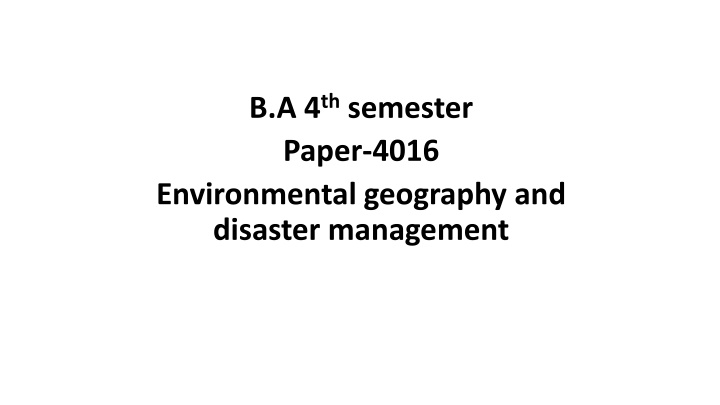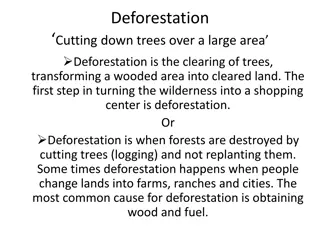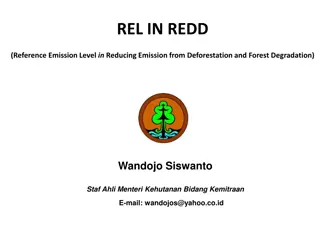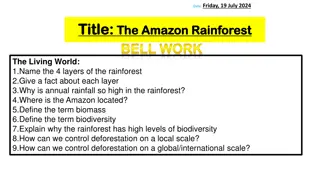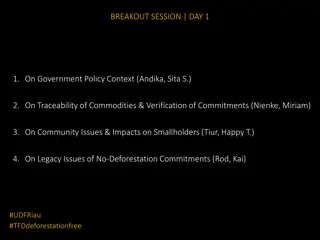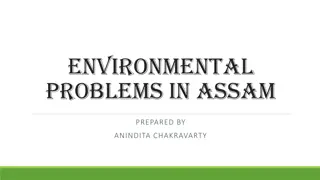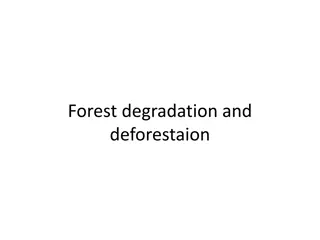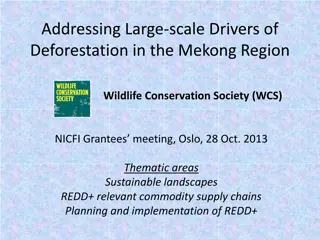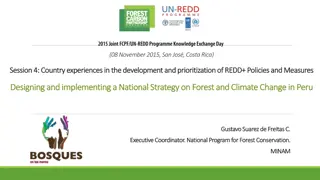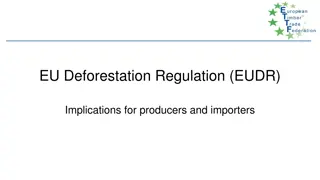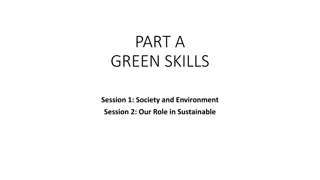The Impact of Deforestation on the Environment and Society
Deforestation, a major global environmental issue, poses threats to ecosystems and communities. The cutting down of forests for various purposes like agriculture and industrial activities leads to habitat loss, soil erosion, and ecological imbalance. This destruction not only affects wildlife and natural resources but also impacts human livelihoods and the environment's ability to provide vital services. Addressing the causes of deforestation is crucial for sustainable land management and disaster prevention.
Download Presentation

Please find below an Image/Link to download the presentation.
The content on the website is provided AS IS for your information and personal use only. It may not be sold, licensed, or shared on other websites without obtaining consent from the author.If you encounter any issues during the download, it is possible that the publisher has removed the file from their server.
You are allowed to download the files provided on this website for personal or commercial use, subject to the condition that they are used lawfully. All files are the property of their respective owners.
The content on the website is provided AS IS for your information and personal use only. It may not be sold, licensed, or shared on other websites without obtaining consent from the author.
E N D
Presentation Transcript
B.A 4thsemester Paper-4016 Environmental geography and disaster management
Deforestation as a major global environment problem Forests are ecological as well as socio-economic resources. Forests have to be managed judiciously not only because they are the source of various products and industrial raw materials but also for environmental protection and various services they provide.Approximately 1/3rd of the earth s total land area is covered by forests. The forests provide habitat for wildlife, resources such as timber, firewood, drugs, etc., and an aesthetic environment. Indirectly, the forests benefit people by protecting watersheds from soil erosion, keeping rivers and reservoirs free of silt, and facilitate the recharging of groundwater. Deforestation Deforestation is a very broad term, which consists of cutting of trees including repeated lopping, felling, and removal of forest litter, browsing, grazing, and trampling of seedlings. It can also be defined as the removal or damage of vegetation in a forest to the extent that it no longer supports its natural flora and fauna.
Causes of Deforestation The most common reason for deforestation is the cutting of wood for fuel, lumber, and paper.Another important cause relates to the clearing of forest land for agriculture, including conversion to cropland and pasture. The main causes of deforestation are: (1) Agriculture The expanding agriculture is one of the most important causes of deforestation.As demands for agricultural products rises, more and more land is brought under cultivation, and for that more forests are cleared, grasslands and even marshes, and lands under water are reclaimed. Thus there is much more ecological destruction than gain in terms of crop yield. The forest soils after clearing are unable to support farming for long periods due to exhaustion of nutrients. Once the soils become unfit for cultivation, the area suffers from soil erosion and degradation.
Commercial or industrial agriculture (field crops and livestock) cause around 40% of forest loss in the search for space to grow food, fibers or biofuel (such as soybeans, palm oil, beef, rice, maize, cotton and sugar cane). It is also particularly interesting to note livestock is believed to be responsible for about 14% of global deforestation. The main reasons why have to do with the large areas require both to raise livestock but also to grow its (soy-based) food. 2. Deforestation Caused By New Constructions The construction of human infrastructures has also been driving deforestation. More specifically, 10% of deforestation can be attributed to new infrastructures that serve the current human lifestyle in four main ways: transportation, transformation and energy generation. On one hand, roads, rails, ports or airports have been built to move all sorts of goods from cereals and fruits to spices, minerals or fossil fuels either directly to trade centers or to transformation sites. So while at first there were only fruit trees, roads soon arrived to allow transporting fruit to other regions.
And while some goods were and are collected manually, others such as coal, oil, natural gas, biomass, but also meat, dairy or spirits, required the construction of large extraction, transportation and/or transformation infrastructures. (3) Demand for firewood Firewood has been used as a source of energy for cooking, heating, etc. Almost 44% of the total global wood produced fulfills the fuel requirements of the world. A close look at the pattern of utilization of wood produced will show that the developed countries utilize 16% of their share for fuel requirements. India consumes nearly 135-170 Mt (Million tons) of firewood annually and 10-15 ha of forest cover is being stripped off to meet the minimum fuel needs of urban and rural poor.
(4) Wood for industry and commercial use Wood, the versatile forest produce, is used for several industrial purposes, such as making crates, packing cases, furniture, matchboxes, wooden boxes, paper and pulp, plywood, etc. Unrestricted exploitation of timber, as well as other wood products for commercial purposes, is the main cause of forest degradation For example, the apple industry in the Himalayan region has led to the destruction of fir and other tree species, for making wooden boxes used for transporting apples. Similarly, plywood crates were used for packing particularly tea and other produce. (5) Urbanization and developmental projects Often urbanization and developmental activities lead to deforestation. The process of deforestation begins with the building of infrastructure in the form of roads, railway lines, the building of dams, townships, electric supply, etc. Thermal power plants, mining for coal, metal ores, and minerals are also important causes of deforestation. (6) Overgrazing of forests of moderate cover by animals mainly in the tropical and subtropical and arid and semi-arid areas has resulted in large-scale degradation of natural vegetation if not the complete destruction of forests.
(7) Other causes Recent developments everywhere in the world have caused large-scale environmental degradation, especially in tropical forest areas. The large amounts of resources living and nonliving (minerals, river, land) found in these forests have attracted both industry and other developmental agencies, which have severely depleted forest cover. Forest fires whether natural or manmade are effective destroyers of forest covers. Consequences of Deforestation Deforestation affects both physical and biological components of the environment. (1) Soil erosion and flash flood A shrinking forest cover coupled with overexploitation of groundwater has accelerated erosion along the slopes of the lower Himalayas and Aravali hills, making them prone to landslides. Destruction of the forests has altered rainfall patterns. Lack of forest cover has resulted in water flowing off the ground, washing away the topsoil which is finally deposited as silt in the river beds. Forests check soil-erosion, landslides, and reduce the intensity of flood and drought. (2) Climatic change Forests enhance local precipitation and improve the water holding capacity of the soil, regulate the water cycle, maintain soil fertility by returning the nutrients to the soil through leaf fall and decomposition of litter. Forests check soil-erosion, landslides, and reduce the intensity of floods and droughts. Forests have a profound effect on the climate. Forest absorbed carbon dioxide from the atmosphere and help in balancing carbon dioxide and oxygen in the atmosphere.
The forests play a vital role in maintaining the oxygen supply in the air, we breathe. They also play a vital role in the regulation of water (water cycle) in the environment and act as environmental buffers regulating climate and atmospheric humidity. Heat build-up in the atmosphere is one of the important problems of the century known as the greenhouse effect is partly caused by the result of deforestation. The entire Himalayan ecosystem is threatened and is under severe imbalance as snow line has thinned and perennial springs have dried up.Annual rainfall has declined by 3 to 4%. Chronic droughts have begun even in areas like Tamilnadu and Himanchal Pradesh where they were not known earlier. (3) Loss of wild life The destruction and alteration of habitats due to deforestation causes an ecological imbalance in the region concerned. The shrinkage of green cover has adverse effects on the stability of the ecosystem.
The Effects Of Deforestation In The Amazon Rainforest Brazil and the Amazon forest are also important (for the wrong reasons) deforestation areas worldwide. The Amazon Rainforest is one of the world s largest forest hotspots, with huge biodiversity reserves. Its ability to store carbon and produce oxygen makes it of the lungs of the planet. According to OECD, the human population is expected to continue to increase and reach over 9 billion people by 2050. At the current rate of consumption, and with more people inhabiting Earth, the need for more space to grow food and extract natural resources is only likely to increase depending, of course, on tech development such as artificial foods. As the demand for food or raw materials like cotton or minerals increases, so does the need to turn forests into farmland, pastureland, or mining spots. Under this broader perspective, how can we stop deforestation?
Conservation Measures The protection and conservation of forest resources are not only desirable but are also necessary for the economic development of a nation and the maintenance of environmental and ecological balance from local through regional to global levels. Integrated Conservation Research (ICR), an ecological group of the U.S.A., has launched massive programs of forest conservation in collaboration with UNESCO s MAN AND BIOSPHERE (MAB) program. The first and foremost task to conserve forests is to protect the existing forests from the merciless and reckless cutting of trees by greedy economic men. This task may be achieved through government legislation and by arousing public interest in the importance of the forest resources.
1. Government Regulations The best solution to deforestation is to curb the felling of trees by enforcing a series of rules and laws to govern it. Deforestation in the current scenario may have reduced; however, it would be too early to assume. The money-churner nature of forest resources can be tempting enough for deforestation to continue. 2. Banning Clear-Cutting of Forests This will curb the total depletion of the forest cover. It is a practical solution and is very feasible. 3. Reforestation and Afforestation Land skinned of its tree cover for urban settlements should be urged to plant trees in the vicinity and replace the cut trees. Also, the cutting must be replaced by planting young trees to replace the older ones that were cut. Trees are being planted under several initiatives every year, but they still don t match the numbers of the ones we ve already lost.
4. Reduce Consumption of Paper Daily consumption of paper includes printing paper, notebooks, napkins, toilet paper, etc.We should try to reduce consumption, reduce waste of paper and also opt for recycled paper products. Make life simple such as printing/writing on both sides of the paper, using less toilet paper, avoiding paper plates, and napkins and wherever possible, go paperless 5. Educate Others Still, many are entirely unaware of the global warming problem we re facing. Educate your friends, family, and community by sharing the deforestation facts, and its causes and effects.Each one of us can make an impact. 6. Eat Less Meat Livestock rearing has become one of the leading causes of deforestation.We should try to eat less meat. It may be hard for some people to try. However, eating less meat, even just for one meal a day, will also make an extreme impact on the environment.
7. Purchase from Sustainable, Forest-Friendly Companies We should try to purchase from companies that are committed to reducing deforestation. 8. Reduce Consumption of Deforestation Prone Products Palm oil is a common ingredient in absolutely everything we see around us. Make it a simple habit to get a quick peek at the ingredients. Soybeans are another deforestation hotspot. Try finding ways to reduce consumption or opting for organic, local soy products and, if possible, avoid it completely.
